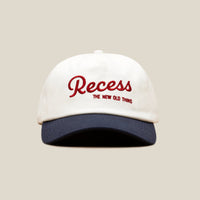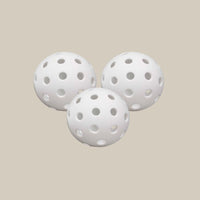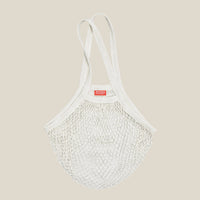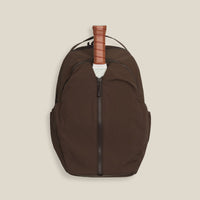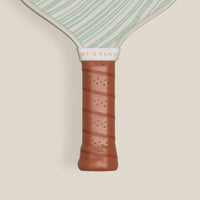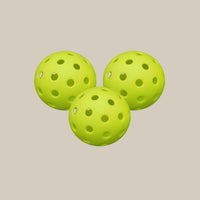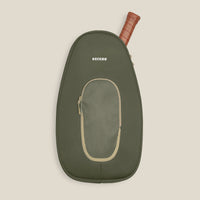Interested in playing pickleball? Read on for our ultimate guide to pickleball, plus the go-to pickleball gear you need to get your game on.
Introduction to Pickleball

Like this paddle? Shop The Optimist paddle and give back to Project Healthy Minds.
The origin of Pickleball
The game of pickleball was invented in 1965 on Bainbridge Island, Washington. Bainbridge is a small, whimsical island full of charm and a short ferry ride from Seattle. Joel Pritchard, Bill Bell and Barney McCallum invented the game for their kids to play during the summer.
The unique name: Why 'Pickleball'?
Joan Pritchard (Joel’s wife) started calling the quirky game pickleball because "the combination of different sports reminded me of the pickle boat in crew where oarsmen were chosen from the leftovers of other boats.”
Why Pickleball is gaining popularity
Though it has humble beginnings, pickleball is now the fastest growing sport in the United States and has gained traction internationally in many European and Asian countries. Pickleball’s unique blend of accessibility, inclusivity, and social benefits has struck a chord with people from all walks of life. Whether you're a seasoned athlete or a curious novice, the allure of this paddle sport lies in its ability to foster fun, fitness, and friendship on and off the court.
Understanding the basics of Pickleball
For the uninitiated, pickleball is a very approachable game that is a mix between ping pong and tennis. Two or four players use composite paddles to hit a plastic pickleball, similar to a wiffle ball, back and forth on a slightly modified tennis court.
Two teams (singles or doubles) send the ball back and forth on the court over a low net. First team to score 11 points by at least 2 wins! Serves must be diagonal and underhand. The ball needs to bounce on each side before a volley (or taking it out of the air). Players can’t hit the ball out of the air while in the Kitchen, aka the non-volley zone.
Equipment Required for Pickleball

The Pickleball Paddle
The pickleball paddle is in between the size of a tennis racket and a ping pong paddle. At Recess, the designs are top-notch, and the technical specs are even better. With a solid honeycomb core, a textured surface for spin, and a grip that feels like heaven, it will quickly become your favorite paddle.
The Pickleball Ball
The pickleball itself is closer in size to a tennis ball, but looks more like a wiffle ball. Recess pickleballs have a strong, durable, and smooth surface. These pickleballs give a great bounce and are the most aesthetically pleasing option on the market.
Court dimensions and layout
The pickleball court is essentially a petite version of a tennis court. A standard court is about 20 feet wide and 44 feet long. You'll find the court split right down the middle into two equal parts, each with a non-volley zone (a.k.a. the "kitchen") close to the net.
Appropriate attire for Pickleball
Comfort is key when it comes to pickleball attire. Opt for breathable, moisture-wicking shirts and shorts to keep you feeling cool on the court. Due to all of the shuffling and quick steps of the fast-paced game, court-specific tennis shoes are important for providing grip and support to move easily around the court.
Need some fresh gear? Shop our favorite pickleball paddles and pickleballs.
Rules and Scoring in Pickleball

Shop Recess Pickleball's Two Paddle Pickleball Set.
The serving rules in Pickleball
Like all racket sports, pickleball starts with a serve. But in the pickleball universe, the serve must take place behind the baseline, be underhanded and below your waist (think: a volleyball serve that’s only underhanded, not overhanded), and land crosscourt into the opposing team’s service court.
Scoring system in Pickleball
In pickleball, points can only be scored by the serving team. Each team has two players, and both players serve consecutively. A game is played up to 11 points, but a team must win by a 2-point margin.
A pickleball score consists of three numbers: the serving team's score, the receiving team's score, and the server number (either 1 or 2). The score is announced before each serve, with the server calling out the entire score. For example, a score may be announced as "4-3-1", with 4 being the server's score, 3 being the opponent's score, and 1 indicating that the first server of the team is on the serve.
Common fouls and penalties
- Double Bounce Violation: In pickleball, the ball must bounce once on each side of the net before players can engage in the "volley" or hit the ball out of the air. If a player tries to volley the ball before it bounces on their side or the opponent's side, it's a double bounce violation, resulting in the loss of the rally.
- Foot Fault: During service, players must keep both feet behind the baseline. Stepping on or over the line while serving is a foot fault and results in a fault or loss of the serve.
- Ball Out of Bounds: If the pickleball lands outside the designated court boundaries, it's considered out of bounds, and the opposing team earns the point.
- Server's Fault: A server commits a fault if the serve does not land within the correct service court, hits the net, or fails to land in the diagonal service box. In such cases, the server loses the serve, and it goes to the opposing team.
Understanding the 'Non-Volley Zone'
The non-volley zone, AKA the kitchen, is the area located seven feet from the net on both sides of the court. It stretches from the net to the non-volley line.
Players cannot hit the ball out of the air (volley) while standing inside the non-volley zone. While this area is off-limits for volleys, once the ball bounces outside of this area, it's fair play! Players can enter the kitchen to hit the ball after it has bounced.
Strategies and Techniques in Pickleball

Shop the limited edition Recess Pickleball x Gray Malin Two Paddle Pickleball Set.
Mastering the serve in Pickleball
The serve is the opening move that sets the tone for the entire point. A strong serve can put your opponents on the defensive right from the start. Here are some tips to improve your serve:
- Find your sweet spot: Experiment with different serves to find the one that suits you best. The traditional underhand serve is the most common, but you can also try the power serve or the spin serve for added variety.
- Keep it low and deep: Aim to keep your serve low over the net and deep into your opponent's court. A well-placed serve can force your opponents to back up, giving you the upper hand in the rally.
- Add some spin: A bit of spin on your serve can make it more challenging for your opponents to handle. Experiment with topspin or sidespin to keep them guessing.
Defensive strategies in Pickleball
Defense wins championships, and in pickleball, it's no different. Being able to defend effectively can frustrate your opponents and force them into making mistakes. Here are some defensive strategies to try out:
- Be patient: Consistency is key—don't rush to attack every ball that comes your way. Sometimes, it's better to play a solid defensive shot and wait for the right opportunity to put the ball away.
- Stay in position: Make sure your side of the court is covered and be ready to move quickly to cover all areas of the court. A solid defensive stance can make it difficult for your opponents to find openings.
- Master the dink: The dink shot is a soft, low shot that lands just over the net. It can be a strong defensive shot, forcing your opponents to hit upward and setting up a potential winning shot for you.
Offensive strategies in Pickleball
Being proactive and dictating the pace of the game can keep your opponents on their toes. Here's some tips for playing on the offensive:
- Target the weak spots: Observe your opponents and identify their weaknesses. Aim your shots at those areas to put them under pressure and force errors.
- Use the kitchen wisely: The non-volley zone, or the kitchen, can be a valuable asset for offensive play. Utilize drop shots or volleys to keep your opponents close to the net, opening up opportunities for deep shots.
- Mix up your shots: Keep your opponents guessing by varying your shots. Combine powerful drives with soft dinks and drop shots to keep them off balance.
For more on pickleball strategies, see our more extensive blog here!
Improving your Pickleball game
Last but not least, the key to becoming a pickleball maestro is continuous improvement. Here are some general tips to enhance your pickleball skills:
- Practice, practice, practice: Regular practice is essential to improvement and developing muscle memory.
- Play with diverse opponents: Playing against different skill levels and styles will challenge you and help you adapt your game.
- Watch and learn: Observe professional pickleball players in action, both in live matches and online. You can gain valuable insights into their strategies and techniques.
Community and Competitions in Pickleball

Shop All Recess Pickleball Paddles.
Finding a Pickleball community
Regardless of age, background, or skill set, we love that pickleball inspires connection and good old fashioned fun. Here's how you can dive into the heart of the pickleball community:
- Local Clubs and Meetups: Check out local pickleball clubs and meetups in your area. These gatherings offer a great opportunity to have fun connecting with new people and create consistency in learning new skills.
- Pickleball Clinics and Workshops: Attend pickleball clinics and workshops conducted by experienced players or coaches. Not only will you sharpen your skills, but you'll also make friendships on and off the court.
Participating in Pickleball tournaments
Ready to up the competition? Whether you're a casual player or a dedicated competitor, tournaments are a great way to get more gameplay experience and meet new people. There’s a range of ways that you can get involved:
- Local Tournaments: Start with local tournaments to dip your toes into the competitive pickleball scene. They often feature multiple skill levels, ensuring that players of all abilities get time on the court.
- Regional and National Events: As you gain confidence and skill, consider participating in regional and national pickleball tournaments. These events draw players from far and wide, providing a fun opportunity to challenge yourself and make memories.
- The Joy of Team Play: Many tournaments offer both singles and doubles events. Grab a partner and embrace the camaraderie of team play!
Famous Pickleball players and influencers
In the world of pickleball, there are several standout players and influencers who have risen to fame and captured the hearts of fans worldwide. One player is Tyson McGuffin, renowned for his exceptional skills, speed, and agility on the court. His numerous tournament victories and charismatic presence have earned him a massive following within the pickleball community. Simone Jardim, often referred to as the "Queen of Pickleball," continues to impress with her impressive on-court performances and remarkable sportsmanship. Her passion for the game and dedication to promoting pickleball have inspired many to take up the sport. These influential players, along with several others, play a pivotal role in popularizing pickleball as the sport of choice for players of all ages and backgrounds.
Future of Pickleball
The future of pickleball is looking bright. As the sport continues to grow in popularity, it is witnessing unprecedented interest and investment. From upgrades in equipment and facilities to the expansion of tournaments and leagues, the future of pickleball looks incredibly promising. Many predict that pickleball will become a mainstream sport, captivating even more players worldwide.
Pickleball is more than just a game; it's a dynamic and constantly growing community that brings together players of all ages and skill levels. We can’t wait to see how far it goes! So, grab your paddle and grab a friend—let’s play!
Shop the go-to pickleball gear you need to get your game on.


